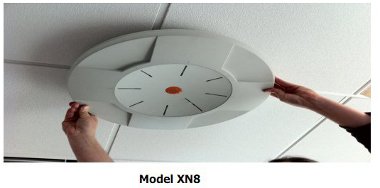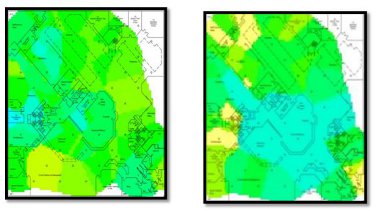Xirrus wi-fi array evaluation
Evaluation: Comparison of Lightweight Access Points and High Density Access Points at Loughborough University
Pranay Pancholi, Loughborough University
February 2011
Introduction
Loughborough University is the largest single site campus university in the United Kingdom, spanning 437 acres of land.
As part of delivering the strategy for the university, a comprehensive, reliable and leading edge wireless network is required, if not demanded.
The student village network known as HALLNET has provided wired connectivity in-house for over ten years. Loughborough University now aims to expand its wireless network infrastructure, supplementing the current 900 Access Points (AP) with ubiquitous coverage for all students living on campus, in both university-owned and privately-funded halls.
Due to the modern construction of buildings and densely populated areas, we frequently encounter scenarios that require a dense wireless deployment.
This evaluation examines the benefits of using the Xirrus 802.11n Wi-Fi Array to provide wireless coverage in comparison with the current lightweight AP configuration.
We placed on trial the Xirrus 802.11n Wi-Fi Array, which has four integrated high gain antennas and dual Gigabit Ethernet uplinks. We used locations in student accommodation, the library, a laptop-based lab and a third stream innovation centre. The evaluation focuses on the deployment in the campus library.
Description of Work
A suitable physical location needed to be chosen to install the Xirrus 802.11n Wi-Fi Array on campus, a prime requirement being a dense wireless environment.
The Pilkington Library was chosen as the best-designated place to carry out this test. It is an open access student facility with a large open plan floor space designed for collaborative working with many desks including power outlets for laptop use. The library also has long opening hours (typically 14
hours daily during term time stepping up to 24 hours for exams and revision dates) and therefore long-term stability is key.
The set-up procedure on the array was initially conducted over a serial console to enable basic network configurations for IP address settings. Once configured on to the network, the remaining attributes could be configured. In all, the array can be configured by using serial console, web interface, Telnet and SSH. We disabled Telnet functions for our trial.
The remainder of the configuration was achieved using the web-based express setup procedure and fine-tuned over SSH. The overall setup configuration procedure with the Xirrus documentation proved easy to implement.
For the trial of the Xirrus array we used the XN8 Wi-Fi Array.
The array was connected via a trunk link to our aggregator switches. As the device was an autonomous standalone (fat) AP, a trunk link was required to provide multiple VLANs for WLAN clients. This aspect was slightly more difficult to configure on the array.
A wireless active survey, using AirMagnet’s Site Survey software, was undertaken as a control for the test and was used to measure wireless network performance, RF coverage and verification of the existing network.
Once this had been completed and recorded, the next stage was to configure and deploy the Xirrus 802.11n Wi-Fi Array into a suitable location. The survey activity was then repeated in exactly the same manner following the installation of the Xirrus device instead of the traditional APs.
Findings
Loughborough University currently uses two types of Cisco Lightweight APs – LWAPP 1131a/b/g and 1142a/g/n. The 1131 APs can support up to 20 clients before performance starts degrading. The 1142N APs are able to support up to 40 clients before significant degrading of performance occurs.
The Xirrus Array evaluation saw a connection of up to 60 clients passing traffic without degradation in performance. The testing was carried out over a three-week period.
The main disadvantage of the evaluation was that testing only involved a single array and this showed mobility issues with associated clients. In some areas of the evaluation our Cisco APs were also present on the periphery. When a device disconnected from the array, it was unable to reconnect to a Cisco AP automatically, resulting in a manual connection on the client. This problem would not persist if multiple arrays were configured using the XMS.
The XMS (Xirrus Management System) provides centralised management of the arrays. Loughborough University currently uses Cisco's WCS (Wireless Control System) to monitor, configure and maintain the current Cisco wireless network infrastructure. XMS fulfils an equivalent role for the arrays. Xirrus Arrays are autonomous (fat) APs; however they can be centrally managed and controlled through the Xirrus Management System. With the size of Loughborough University’s campus (437 acres), a central management solution would be a definite requirement
Real time network monitoring and mapping would be the most beneficial tool that would come with the XMS, especially with the growth of organisation sizes and the increasing number of APs being rolled out.
The Xirrus array automatically balances its (2.4GHz) antennas using non-overlapping channels 1/6/11 simultaneously. Whilst we used automatic channel selection for the trial, manual channel selection is available. The Xirrus Array supports the full range of ETSI channels including, in the 5GHz range, UNII 1, 2 and 3.
RF Output
Existing AP survey (left), AP survey with Xirrus Array (right)
The second survey with Xirrus Array in operation shows that with its integrated four high gain antennas demonstrated better signal strength at various staged intervals, moving further away from the AP.
In the original configuration, there were three Light Weight Access Point Protocol (LWAPP) devices in place. From this test and in these specific circumstances the three LWAPP’s could be replaced with one single Xirrus device within the central location.
User Density
As the current LWAPP’s only have one radio there is a limit on how many end users can connect to each device. Therefore multiple LWAPP devices are required to support a large volume of users. The library location is a prime example of this and during exam and coursework deadline dates at the end of each semester the volume of users connecting to the wireless network is very high.
The Xirrus Array consists of additional radios in each of its Array within a singular device, therefore one is able to spread the antennas across various channels. This therefore reduces interference, thus improving user density over the default configuration.
Using more RF spectrum does not directly affect the maximum user density; we noticed lowering power on all channels was sufficient due to the multiple antennas in place. When testing within a known dead spot in the trial, power was increased which provided sufficient coverage, thus eliminating the dead spots.
Rogue Access Point Detection
The Xirrus Array consists of integrated rogue AP detection features that scan for any possible rogue APs that may exist within the area of the array. This feature was manually disabled as part of our testing, due to conflicts with the university existing network model.
We currently use our existing rogue detection methods within our built in network monitoring tools to monitor across campus. The Array highlights any existing APs as rogue - however an allow/known AP list can be created to stop such APs being flagged as rogue.
The centralised XMS management system would eliminate the requirement for single array configurations; this means that template configurations can be configured for simpler installation/rollout of multiple arrays on campus and therefore the configuration of rogue AP detection across the estate.
Summary
In our testing of the Xirrus 802.11n Array the device gave us four additional benefits: Increased gain in RF Signal output in comparison to existing model due to multiple 3x3 MIMO integrated high gain antennas. A single array to support hundreds of client devices. Dual Gigabit Ethernet uplinks for optimal bandwidth. The combination of multiple radios and high signal gain results in fewer installations of APs to a ratio of 1:3. This reduces installation time and the number of switch ports and requires less cabling.
Note: This is a technical focused evaluation, and we have not looked at the total cost of ownership, related costs, licensing and other factors that would need investigation as part of the procurement process.
Contact
Pranay Pancholi, Network & Security Team, Loughborough University, 01509 226067, p.m.pancholi@lboro.ac.uk








